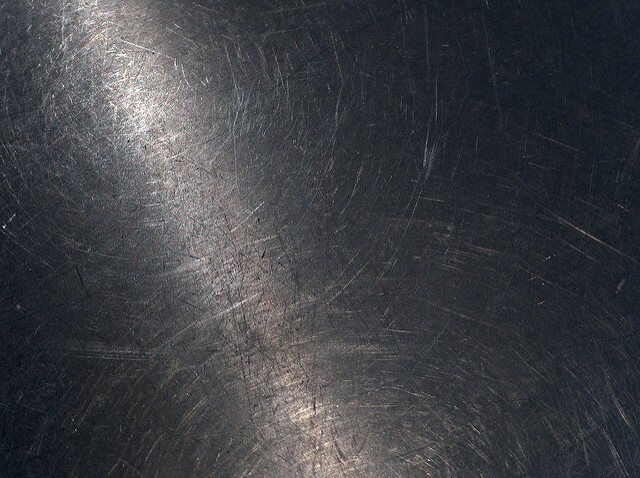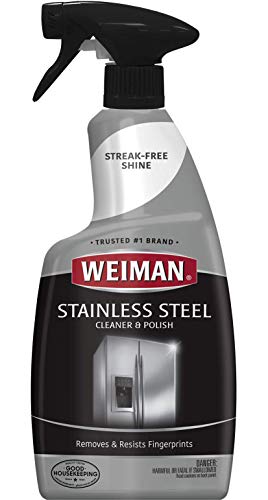
Who doesn’t dread the task of cleaning the refrigerator?
I’ve often wished the manufacturers would market a fridge with a patterned, streaked exterior so the dirt and grease won’t show. We’d just gotten into the habit of cleaning our white, eggshell, or cream-colored models. Then suddenly, we have stainless steel fridges that make even the streaks from the cleaning cloth glaringly obvious.
The cleaning product
You have a choice of many cleaning products to use on the exterior of your refrigerator. Any good general purpose cleaning product should work, and a spray bottle is essential. If you have a stainless steel refrigerator, make sure you read the cautions before you buy a cleaner, so that you can be certain it won’t damage the finish.
For a simple cleaning solution, use a 1:1 mixture of white vinegar and water in a spray bottle. You can also use dish soap and water.
Do you have some particularly horrifying grime, small children, or pets whose fur (and paw prints) clings to the layer of cooking grease already there? No shame. Life happens and it’s our task to deal with the result. Just have some have some baking soda and vinegar ready!
Check out ARM & HAMMER Baking Soda at Amazon
Learn about how you can use baking soda to clean the interior of your oven.
Cleaning cloths
Microfiber cloths are excellent for cleaning refrigerators, especially for stainless steel models. In their absence, use an old, worn t-shirt or a soft sponge.
Check out Zwipes Microfiber Cleaning Cloths at Amazon
Sponges are great for refrigerators that simply have some dust and grime, but removing fur and heavy dust is tough with a sponge. You might want to try one of these sponges ideal for stainless steel cookware. Do not use an abrasive sponge, as it could damage the surface.
Another option is to use a paper towel. These can create additional waste, so choose an eco-friendly brand that can be recycled.
Check out this post on how to keep kitchen towels clean and odor-free.
To being, wipe the refrigerator down with a dry cloth to get loose any dust, hair, fur, and fluff. Start at the top and work your way down, brushing detritus onto the floor.
Precautions
The following general precautions are for all refrigerators, regardless of whether they are enamel or stainless steel. Do not use:
- Abrasive cleaners
- Alcohol on stainless steel refrigerators, although you may use it on enamel refrigerators.
- Ammonia
- Flammable liquids
- Nail polish remover
- Oven cleaner
- Stainless steel pads or any abrasive scrubbers, such as steel wool
Check the owner’s manual for tips on cleaning your refrigerator. Some stainless steel refrigerators are coated with a clear finish and many cleaning products can damage that coating.
Stainless steel refrigerators
Let’s go ahead and acknowledge that stainless steel is different.
If you have a stainless steel refrigerator that isn’t terribly dirty, a dry microfiber cloth rub may be all you need. Remember to start cleaning from the top down.
Be certain not to put a great deal of pressure when scrubbing so as not to mar the surface. If you have some stubborn spots, use the white vinegar and water mixture or an LCD cleaner designed to clean televisions and computer displays. Wipe in the direction of the “grain” of the stainless steel, and avoid using a crisscross method. You don’t want to leave streaks.
Some products to use with stainless steel include:
- Dishwashing liquid and water solution, or dishwashing liquid with baking soda for stubborn spots
- White vinegar and water in a 1:1 solution
- Special non-abrasive cleaners made for cleaning surfaces like ceramic stoves and stainless steel appliances
- A few drops of olive oil on a dry cloth
- Microfiber cloths, soft t-shirt material, and nylon “scrubbies”
If you’re concerned your cleaner might damage the finish, use it first on a portion of the refrigerator near the back and bottom.
After you clean the refrigerator, use a fresh damp cloth to “rinse” any soap or baking soda from the exterior after cleaning.
Check out Weiman Stainless Steel Cleaner & Polish at Amazon
Buff the refrigerator with a soft dry cloth to remove any streaks from cleaning.
Scratches

No one likes to see scratches on their kitchen appliances. If your stainless steel refrigerator is scratched or scuffed, you can sometimes buff out minor abrasions with soft-bristled toothbrush and whitening toothpaste. Powdered cleaners, like Comet, may also do the trick.
Check out Comet Cleanser with Bleach at Amazon
You can treat deep scratches by using sandpaper (check with the manufacturer to learn about which grit to use). This method may dull the finish of your refrigerator, however. Additionally, there are numerous scratch-removal kits available on the market.
Always buff scratches with the grain of the metal, or you risk further damage. In some cases, it is simply better to have them professionally removed.
Enamel refrigerators
For enamel exteriors, the following list of cleaning products is sufficient to produce a really good clean:
- A mixture of hand dishwashing liquid and water
- A 1:1 white vinegar and water solution
- General purpose cleaning solutions (always check the label for precautions)
- Rubbing alcohol for stubborn grease
- For stubborn spots, some dishwashing liquid and baking soda, or rubbing alcohol
Starting at the top, spritz an area with your cleaner. If you have a lot of grease or dirt on the area, get a really good coating of cleaner and let it sit for a few minutes to loosen the grease and dirt.
Wipe gently with a moist cloth or your sponge. Scrub badly soiled or greasy spots, putting pressure on the cloth as you scrub.
Wipe the refrigerator down with a damp cloth to remove leftover cleaner, then with a towel or dry cloth to buff the outside.
Coils
The condenser coils are part of the refrigerator so don’t ignore them. They should be cleaned twice a year.
First unplug the refrigerator from the wall socket and move it out into the room.
If you have coils on the back of the refrigerator, use a vacuum cleaner with a soft brush attachment to vacuum loose dirt. If there is any residue clinging to the coils afterward, just wipe with a dry cloth or with a cloth dampened with warm water and a little liquid dish soap.
Use a clean, damp cloth to remove any soap residue.
Remove the plastic covering from the bottom of your refrigerator and vacuum the grille beneath it. Wash the plastic covering in warm soapy water and rinse clean. Wipe it with a clean dry cloth or towel and replace.
Prevention
To keep your refrigerator clean, put it on a schedule. Pick a day of the week, and every week, clean the exterior of your refrigerator. If you live in an area near the ocean, where salt water can corrode the refrigerator surface, wipe down the outside of the refrigerator every time you do dishes.
Wash the interior of the refrigerator monthly. Clean the coils and grilles twice a year.
Once your refrigerator is clean and on schedule, the task of cleaning it will become far less daunting!
For more cleaning tips for the kitchen, check out these posts on the best oven cleaner and how to deep clean a coffee pot. You might also be interested in this article on cleaning accessories for cast iron, to keep your cast iron properly maintained.
Then take a look at my roundup of the best pots for boiling eggs.









Bryce is not a real professor, but he's real nerdy in the kitchen. He's been barbecuing, chopping, and generally blazing food for many decades. He thinks there's definitely a better spatula or utensil out there that hasn't been invented yet.